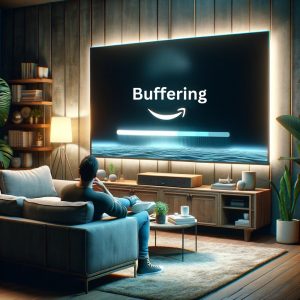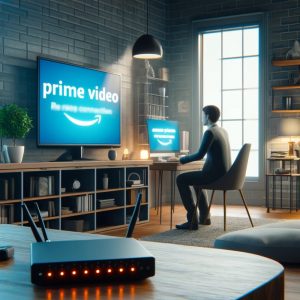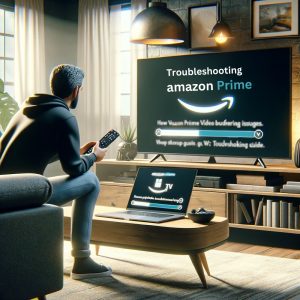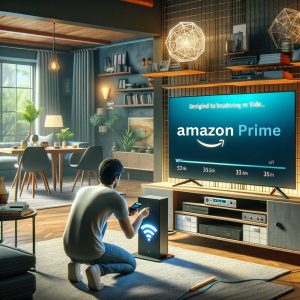Amazon Prime Video Keeps Buffering
In the world of digital streaming, where entertainment and information are accessible at the click of a button, the importance of a seamless viewing experience cannot be overstated. Whether you’re settling down for a movie night or catching up on your favorite series, interruptions like buffering on Amazon Prime can significantly detract from your enjoyment and immersion. Unfortunately, Prime Video buffering issues are not uncommon and can arise due to several factors ranging from network connectivity to app glitches.

For millions of subscribers, Amazon Prime keeps buffering despite having robust internet connections, leading to frustration and a less than ideal user experience. This problem can be particularly annoying when you’re looking forward to unwinding with some of the exclusive and popular content available on Amazon Prime Video. The recurring issue of Prime Video keeps buffering disrupts not only the flow of entertainment but also highlights potential underlying problems that could be at play.
In this blog, we aim to explore why Amazon Prime Video keeps buffering and provide practical solutions to help you overcome this challenge. From simple fixes that you can apply immediately to more comprehensive troubleshooting methods, our goal is to help you restore your streaming experience to its optimal state. Let’s dive into the common reasons behind these disruptions and discuss how to address them effectively, ensuring that your next streaming session is as smooth as it is entertaining.
Understanding Buffering Basics and Impact
Buffering is an integral part of streaming technology, designed to facilitate uninterrupted playback of video content on platforms like Amazon Prime Video. Essentially, buffering involves pre-loading portions of the video onto your device to ensure that it continues to play smoothly even if there are temporary internet slowdowns. However, when buffering on Amazon prime happens more frequently than expected, it indicates that the video data isn’t being downloaded quickly enough to keep up with playback, leading to annoying pauses and stalls.

Several issues can lead to Amazon Prime buffering issues, including insufficient internet speeds, weak Wi-Fi connections, or excessive network traffic. On occasion, the problem might also stem from Amazon’s servers themselves, asking viewers to wonder: Why does Amazon Prime Video buffers even when all local conditions appear optimal?
The consequences of persistent buffering on Amazon Prime extend beyond mere technical glitches. They significantly degrade the user experience, interrupting the narrative flow of movies and shows and creating a frustrating viewing environment. This is especially aggravating during key moments of a program or live event, where buffering on Amazon prime can cause viewers to miss important scenes or action.
Moreover, ongoing Prime Video buffering problems can impact viewer satisfaction and loyalty, as users may consider switching to other streaming services that offer more reliable playback. To address and mitigate these Amazon Prime buffering issues, it’s essential to delve deeper into both the common causes and potential fixes, ensuring a smoother streaming experience on Amazon Prime Video for all subscribers.
Common Reasons Why Amazon Prime Video Keeps Buffering
Amazon Prime Video buffering issues can be a source of significant irritation for viewers, disrupting their streaming experience. Understanding the common causes behind these interruptions can help to identify and resolve the issue effectively. Here are some of the primary reasons why Amazon Prime Video keeps buffering:

-
Internet Connection Speeds:
The cornerstone of any smooth streaming experience is a stable and fast internet connection. Amazon Prime Video buffering can often be attributed to internet speeds that are insufficient to handle the high bandwidth requirements of HD and ultra-HD video streams. Streaming platforms like Amazon Prime Video recommend specific internet speeds for different quality settings, and failing to meet these can lead to frequent Prime Video buffering.
-
Device Performance:
Not all devices are created equal, particularly when it comes to processing and rendering high-definition video streams. Older or overloaded devices may lack the necessary processing power, leading to buffering on Amazon Prime. This is particularly true for older smart TVs, tablets, or smartphones, which might struggle to manage the data flow required for uninterrupted streaming, contributing to Amazon Prime buffering issues.
-
Network Congestion:
Another critical factor is network congestion. When multiple devices are connected to the same network and simultaneously using bandwidth-intensive services, it can strain the network and cause buffering on Amazon Prime. This is common in households where several people are seeing videos, playing online games, or downloading big files at the same time.
-
Server Issues:
Sometimes the problem might not be on your end at all. Amazon Prime Video buffering can also occur due to issues with Amazon’s servers, such as high traffic during peak hours or technical faults that temporarily disrupt service. These server issues can prevent your device from receiving data efficiently, leading to buffering on Amazon Prime.
Understanding these common causes behind buffering can guide you towards the appropriate solutions, whether it’s upgrading your internet plan, optimizing your device settings, managing network access at home, or simply being patient while Amazon resolves server-side issues. Addressing these factors can significantly reduce the occurrence of Amazon Prime buffering issues, enhancing your overall streaming experience.
Troubleshooting Steps to Fix Buffering on Amazon Prime Video
Experiencing buffering on Amazon Prime can detract from your enjoyment of movies and TV shows. To help mitigate Prime Video buffering issues, here are several troubleshooting steps you can follow. These steps are designed to tackle problems related to Amazon Prime video keeps buffering:

-
Checking Internet Speed and Stability:
The first step in addressing Amazon Prime buffering is to ensure your internet connection is quick and steady enough for streaming. Use internet speed test tools available online to measure your download speed. Amazon Prime Video generally requires at least 5 Mbps for HD streaming and 25 Mbps for Ultra HD. If your results are consistently lower, consider upgrading your internet plan or contacting your ISP.
-
Enhancing Wi-Fi Signal:
A weak Wi-Fi signal can lead to Amazon video buffering. Improve your Wi-Fi signal by placing your router in a central location away from walls and obstructions. Consider upgrading to a higher-quality router or adding a Wi-Fi extender to imcrease the signal strength throughout your home.
-
Clearing Cache and Data of Your Device:
Over time, your streaming device may accumulate cache and data that can affect its performance, contributing to buffering on Amazon Prime. Clearing the cache and data from your device can free up resources and improve streaming quality. The process varies by device, but typically involves going to the settings menu, selecting the Amazon Prime Video app, and clearing its cache and data.
-
Updating the Amazon Prime Video App:
An outdated app can lead to buffering on Amazon Prime due to compatibility issues or unpatched bugs. Ensure your Amazon Prime Video app is updated to the most recent version by checking the app store on your device and applying any available updates.
-
Restarting Devices:
Sometimes, a simple restart can resolve Prime Video buffering This action refreshes your device’s operating system and clears temporary files, which might be causing the app to lag or buffer.
-
Alternative Solutions:
If Amazon Prime buffer problems persist, consider switching from a Wi-Fi connection to a wired Ethernet connection, which can provide a more stable and faster internet connection. Additionally, adjusting the stream quality settings within the Amazon Prime Video app can reduce the bandwidth required and may help minimize buffering.
By following these troubleshooting steps, you should be able to significantly reduce or even eliminate Amazon Prime Video keeps buffering issues, leading to a smoother and more enjoyable streaming experience. If you still face issues with streaming, you can read our detailed blog on Amazon Prime Streaming Issues and get the desired solution.
Preventive Measures to Avoid Future Buffering on Amazon Prime
To make sure a smooth, uninterrupted streaming experience on Amazon Prime Video and to minimize the occurrence of buffering on Amazon Prime, it’s important to implement preventive measures. These steps will help you maintain optimal conditions for streaming and prevent Prime Video buffering from becoming a recurring issue:

-
Regular Maintenance Tips for Devices and Network:
-
Update Regularly:
Ensure that your streaming devices and any associated software are regularly updated. Updates often include critical patches that can enhance performance and security, which can help prevent buffering on Amazon Prime.
-
Monitor Network Health:
Regularly check your network for signs of issues, such as unusually slow internet speeds or intermittent connectivity. Tools like network monitors can help you visualize network usage and identify potential problems that could lead to Amazon Prime buffering issues.
-
Optimize Device Performance:
Keep your devices in good working order by closing unused apps and clearing the cache periodically. Overburdened devices can slow down and struggle with data-intensive tasks like streaming, leading to Prime Video buffering.
-
-
Recommended Settings for Optimal Streaming Experience on Amazon Prime Video:
-
Adjust Stream Quality of Amazon Prime Video:
Amazon Prime Video allows you to adjust the stream quality. If you are experiencing frequent buffering on Amazon Prime, consider setting the video quality to a lower resolution. This can be particularly effective if your internet speed is variable.
-
Wired Connection:
Whenever possible, use a wired Ethernet connection instead of Wi-Fi. This can provide a more stable and faster internet connection, reducing the chances of Amazon Prime Video keeps buffering.
-
Limit Bandwidth Usage:
During peak streaming times, limit other devices’ internet usage. Devices downloading large files or performing updates can consume significant bandwidth, contributing to Amazon Prime buffering issues.
-
Router Settings:
Make sure your router settings are optimized for streaming. Features like Quality of Service (QoS) can prefer traffic to your streaming devices, ensuring they get the bandwidth needed to prevent Prime Video buffering.
-
By adopting these preventive measures, you can enhance your streaming experience, reducing the likelihood of facing buffering on Amazon Prime. Regular maintenance of your devices and network, along or adjusting your streaming settings as recommended, will help maintain a consistent and enjoyable viewing experience on Amazon Prime Video.
FAQs
Q. Why does Prime Video keep buffering when I try to watch a movie?
- A. Amazon Prime Video keeps buffering due to a variety of reasons, such as slow internet speeds, device performance issues, or network congestion. Ensuring a stable and fast internet connection can help resolve this issue.
Q. What can I do if Amazon Prime Video keeps buffering on my smart TV?
- A. If Amazon Prime Video keeps buffering on smart TV, try improving your Wi-Fi signal, checking for updates on your smart TV, or connecting your TV directly to the internet with an Ethernet cable.
Q. How can I fix buffering on Amazon Prime on my mobile device?
- A. To fix buffering on Amazon Prime on a mobile device, clear the app cache, ensure your app is updated, and try restarting your device to refresh the connection.
Q. Why does Amazon Prime buffer more during evenings?
- A. Amazon Prime buffer issues during evenings are often due to increased internet traffic in your area. Try reducing video quality settings or streaming during off-peak hours.
Q. What should I do when Prime Video buffering doesn’t stop?
- A. Continuous Prime Video buffering could be due to underlying network problems. Check your internet speed, and think about upgrading your internet plan or optimizing your home network layout.
Q. How can clearing cache help if my Amazon Prime keeps buffering?
- A. Clearing cache removes stored data that may be causing the app to lag or stall. This can often resolve Amazon Prime keeps buffering by allowing the app to function more efficiently.
Q. Why does my Prime Video keep buffering despite a good internet connection?
- A. Even with a good internet connection, why does my Prime Video keep buffering can be attributed to other factors like server problems from Amazon’s side or too many devices connected to your network.
Q. Can adjusting the video quality on Amazon Prime Video reduce buffering?
- A. Yes, adjusting the video quality to a lower setting can help minimize Amazon video buffering, especially if your internet speed does not support high-definition streaming.
Q. What are the best ways to prevent future Amazon Prime Video buffering?
- A. To prevent future Amazon Prime Video buffering, maintain regular updates on your devices, use a wired connection if possible, and manage your home network to avoid congestion.
Q. Why does Amazon Prime Video keep buffering only on certain shows?
- A. If Amazon Prime Video keeps buffering on certain shows, it could be due to higher data requirements for those particular shows or temporary issues with specific content servers at Amazon.
Conclusion
Throughout this blog, we’ve explored several key aspects and solutions related to the frustrating issue of buffering on Amazon Prime. From understanding the basic mechanisms of Prime Video buffering to delving into common causes such as slow internet speeds, overloaded devices, and network congestion, we’ve covered a comprehensive range of factors that can impact your streaming quality. We’ve also provided actionable troubleshooting steps designed to fix and prevent buffering on Amazon Prime, ensuring a smoother and more enjoyable viewing experience.
To recap, remember that maintaining a strong and stable internet connection, keeping your devices and apps up-to-date, and optimizing your home network setup are all critical steps in combating Prime Video buffering. Regularly clearing cache, rebooting your devices, and possibly even adjusting your streaming settings can make a significant difference in how well your content plays.
We encourage you to try out the solutions mentioned in this guide. Whether it’s a simple device restart or a more involved approach like enhancing your Wi-Fi signal or connecting directly via an Ethernet cable, these strategies are designed to tackle the issue of Amazon Prime keeps buffering effectively. Each step you take not only improves your current viewing experience but also helps prevent future disruptions.
We appreciate your presence as we explore deeply into how to combat Prime Video buffering. We hope the insights and tips provided will empower you to take control of your streaming experience and enjoy uninterrupted entertainment on Amazon Prime Video. Here’s to many more buffer-free movie nights and binge-watching sessions!
To know more about Amazon Prime Video Keeps Buffering and other issues, visit our Amazon Prime Video Support Page.

Susan young
Why does Prime Video keep buffering even though I have a fast internet connection, and how can I resolve this issue?
Support Admin
Prime Video buffering can occur despite having a fast internet connection due to several underlying issues. Amazon Prime Video buffering might be attributed to device performance issues, such as older devices struggling to handle high-definition streams. Additionally, network congestion in your local area can slow down your effective internet speed during peak hours, leading to Amazon Prime buffering issues. It’s also possible that the Amazon servers are experiencing high traffic or temporary technical faults. To resolve this, ensure your streaming device is updated, clear cache and data, and consider using a wired Ethernet connection for more stable internet access. By taking these steps, you can help mitigate buffering and enjoy a smoother viewing experience.